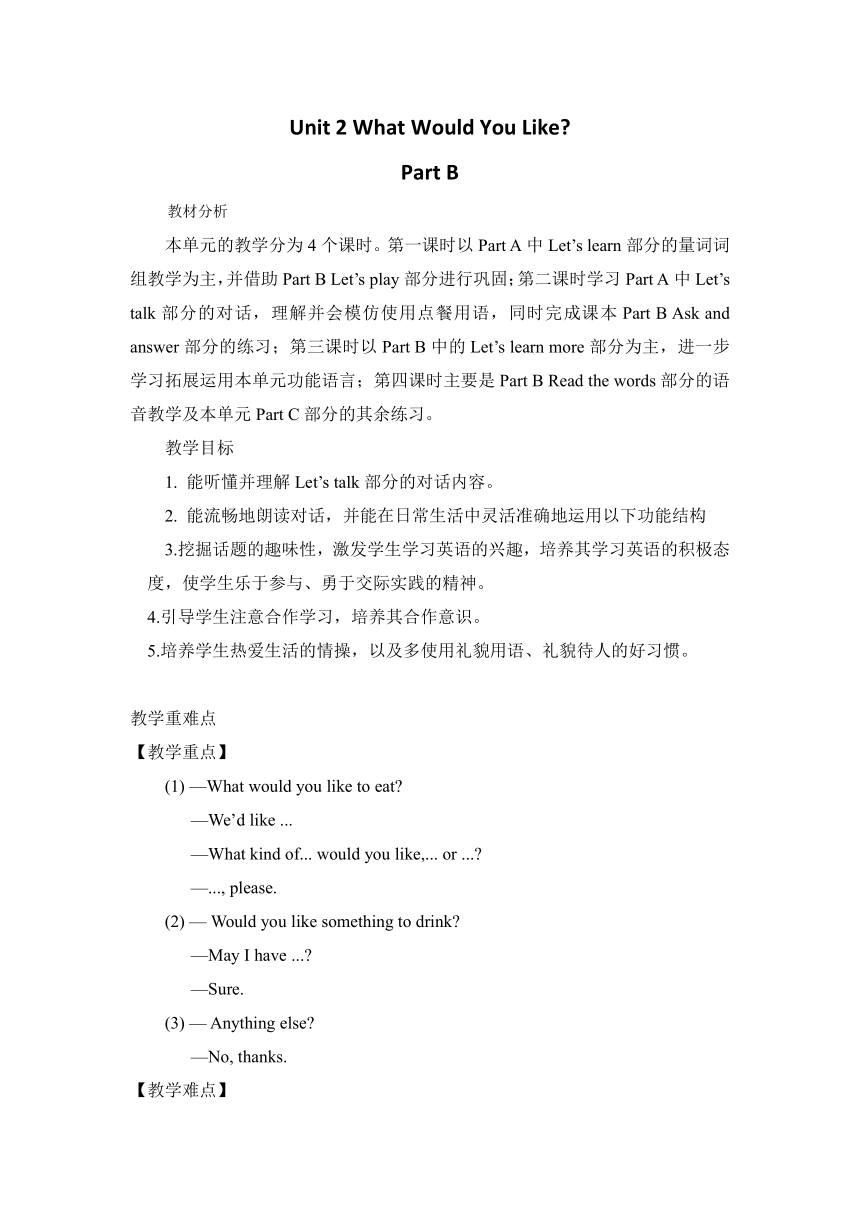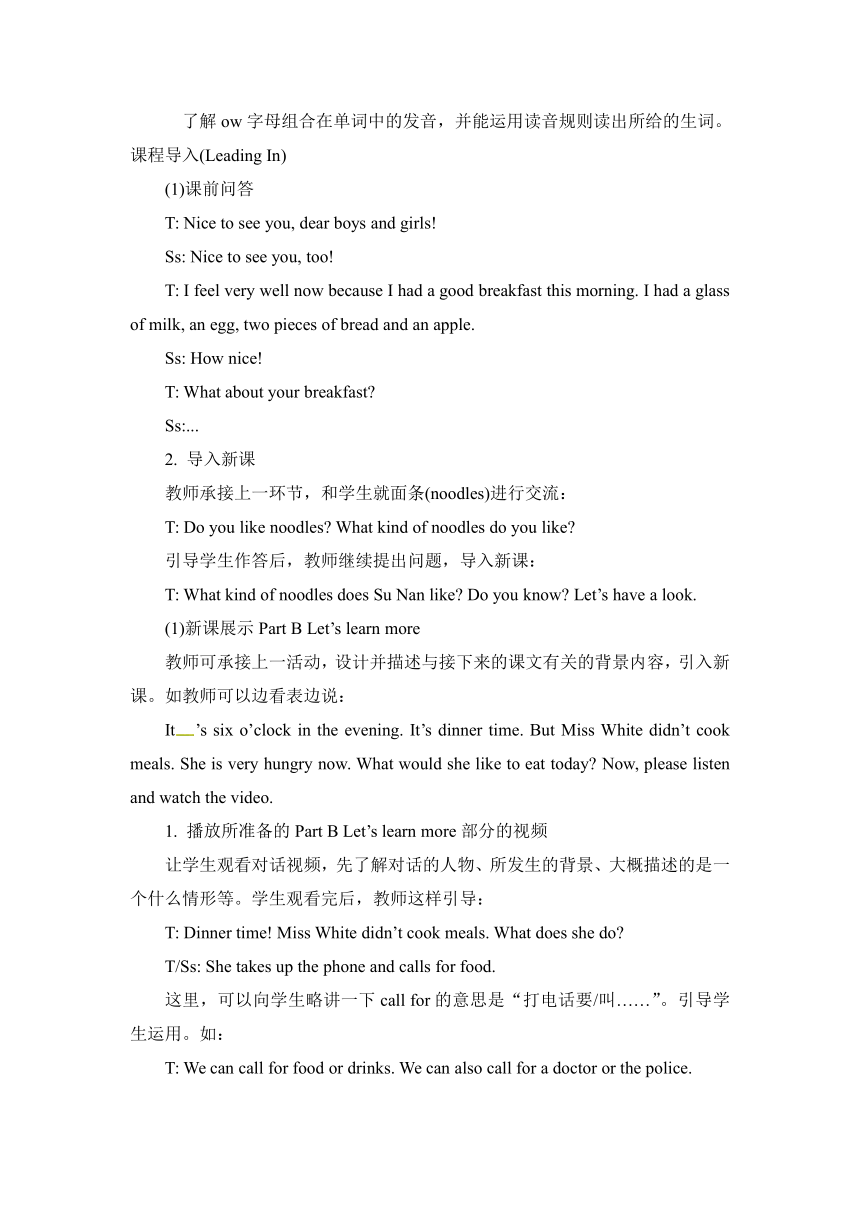Unit2 What Would You Like? partB 教案
文档属性
| 名称 | Unit2 What Would You Like? partB 教案 |  | |
| 格式 | doc | ||
| 文件大小 | 43.0KB | ||
| 资源类型 | 教案 | ||
| 版本资源 | 陕旅版 | ||
| 科目 | 英语 | ||
| 更新时间 | 2021-06-03 15:06:19 | ||
图片预览


文档简介
Unit
2
What
Would
You
Like?
Part
B
教材分析
本单元的教学分为4个课时。第一课时以Part
A中Let’s
learn部分的量词词组教学为主,并借助Part
B
Let’s
play部分进行巩固;第二课时学习Part
A中Let’s
talk部分的对话,理解并会模仿使用点餐用语,同时完成课本Part
B
Ask
and
answer部分的练习;第三课时以Part
B中的Let’s
learn
more部分为主,进一步学习拓展运用本单元功能语言;第四课时主要是Part
B
Read
the
words部分的语音教学及本单元Part
C部分的其余练习。
教学目标
1.
能听懂并理解Let’s
talk部分的对话内容。
2.
能流畅地朗读对话,并能在日常生活中灵活准确地运用以下功能结构[]
3.挖掘话题的趣味性,激发学生学习英语的兴趣,培养其学习英语的积极态度,使学生乐于参与、勇于交际实践的精神。
4.引导学生注意合作学习,培养其合作意识。
5.培养学生热爱生活的情操,以及多使用礼貌用语、礼貌待人的好习惯。
教学重难点
【教学重点】
(1)
—What
would
you
like
to
eat?
—We’d
like
...
—What
kind
of...
would
you
like,...
or
...?
—...,
please.
(2)
—
Would
you
like
something
to
drink?
—May
I
have
...?
—Sure.
(3)
—
Anything
else?
—No,
thanks.
【教学难点】
了解ow字母组合在单词中的发音,并能运用读音规则读出所给的生词。
课程导入(Leading
In)
(1)课前问答
T:
Nice
to
see
you,
dear
boys
and
girls!
Ss:
Nice
to
see
you,
too!
T:
I
feel
very
well
now
because
I
had
a
good
breakfast
this
morning.
I
had
a
glass
of
milk,
an
egg,
two
pieces
of
bread
and
an
apple.
Ss:
How
nice!
T:
What
about
your
breakfast?
Ss:...
2.
导入新课
教师承接上一环节,和学生就面条(noodles)进行交流:
T:
Do
you
like
noodles?
What
kind
of
noodles
do
you
like?
引导学生作答后,教师继续提出问题,导入新课:
T:
What
kind
of
noodles
does
Su
Nan
like?
Do
you
know?
Let’s
have
a
look.
(1)新课展示Part
B
Let’s
learn
more
教师可承接上一活动,设计并描述与接下来的课文有关的背景内容,引入新课。如教师可以边看表边说:
It’s
six
o’clock
in
the
evening.
It’s
dinner
time.
But
Miss
White
didn’t
cook
meals.
She
is
very
hungry
now.
What
would
she
like
to
eat
today?
Now,
please
listen
and
watch
the
video.
1.
播放所准备的Part
B
Let’s
learn
more部分的视频
让学生观看对话视频,先了解对话的人物、所发生的背景、大概描述的是一个什么情形等。学生观看完后,教师这样引导:
T:
Dinner
time!
Miss
White
didn’t
cook
meals.
What
does
she
do?
T/Ss:
She
takes
up
the
phone
and
calls
for
food.
这里,可以向学生略讲一下call
for的意思是“打电话要/叫……”。引导学生运用。如:
T:
We
can
call
for
food
or
drinks.
We
can
also
call
for
a
doctor
or
the
police.
接下来继续就课文发问,并引导学生作答:
T:
Who
answers
her
call?
T/Ss:
A
waiter.
2.
教师可以根据对话内容设计几个问题。请学生自主阅读对话之后,教师可采用个别回答或集体回答问题的方式了解学生们的阅读效果。问题设计参考如下:
(1)
Who
does
Miss
White
call
to?
(A
restaurant
called
Happy
Fast
Food.)
(2)
What
would
Miss
White
like
to
eat?
(Chicken
and
hamburgers.)
(3)
What
would
Miss
White
like
to
drink?
(A
bottle
of
juice
and
a
bottle
of
milk.)
(4)
Where
does
Miss
White
live?
(No.11
Garden
Road.)
(5)
How
much
are
the
food
and
drinks?
(Thirty-four
yuan.)
3.
让学生集体朗读对话之后,教师帮助学生完整理解对话内容。
(1)
注解单词address是“地址”的意思。
教学小贴士
教师在这里可以借助单词address的读音和拼写,向学生渗透拼读规律和记忆单词的方法:[]
address是由ad+dress构成,其中,第一个d不发音,而后面的部分则\是以前学过的单何dress(连衣裙),读音不变。
此处,教师也可适当补充地址的询问方式:What’s
your
address?
(2)
How
much
are
they?
关于如何询问价格,学生们并不陌生;教师在这里注意提醒他们,单对食物(food)的价格或是单种类饮品的价钱询问时,要用单数。
如:
How
much
is
the
food?
How
much
is
the
juice?
但当对食物和饮品合在一起的价钱询问时则要用复数,如:
How
much
are
the
food
and
drinks?
How
much
are
they?
(2)巩固活动
1.
教师播放Let’s
learn
more部分的录音,让学生模仿其语择语调跟读对话。
2.
Read
again
and
answer
the
questions
先让自己读读本部分的五个问题,然后让学生再次朗读对话。之后,同桌一组进行问答练习,完成本部分的相关问题。
参考答案:
1.
She
calls
for
supper.
/
She
calls
for
some
food
and
drinks.
2.
Chicken
hamburgers.
3.
She
would
like
juice
and
milk.
4.
She
lives
on
No.
11
Garden
Road.
5.
Thirty-four
yuan.
(2)Part
B
Let’s
play
1.
教师可以这样创设情景,进行问答练习:Look!
It’s
dinner
time.
You
are
hungry.
What
food
would
you
like?学生回答:I
would
like
...也可以接着问:It’s
very
hot.
You
are
thirsty.
What
drink
would
you
like?
学生回答:I’d
like
...引导学生使用量词词组说出各自想要的食品或饮品。
2.
把学生分成小组,组织学生进行“句子接龙”游戏。小组内每个人分别运用正确的量词词组说出各自想要的物品,而且数量要依次递增。如:
S1:
I’d
like
a
glass
of
water.
S2.(叫出下个学生名字)
S2:
I’d
like
two
pieces
of
cakes.
S3.
S3:
I’d
like
three
plates
of
beef.
S4.
S4:
I’d
like
four
bowls
of
rice.
S5.
S5:
I’d
like
five
bottles
of
milk.
S6.[]
S6:
I’d
like
six
...
S7.
...
教师要注意学生对量词词组的单1数或复数形式的正确运用。
3.
选出几位学生在班内进行展示。
(2)Part
B
Let’s
act
这是一个有情景的语用练习。教师首先把课本P14的菜单内容展示在PPT课件上,所有学生统一看黑板PPT上的菜单。然后,让学生自愿选择进行角色扮演,角色分別为:waiter/waitress和customer。每组参与的学生到讲台前为大家表演情景会话要求其他学生注意观察、倾听,并为接下来的表演参与做准备。
注意:每一组学生表演完后,要进行评价。先由学生来评价,然后教师进行评价与演读的指导。教师可以这样来介绍和组织:
Now,
everybody.
Look!
This
is
a
menu
from
Happy
Fast
Food.
Next,
you
have
a
chance
to
be
an
actor
or
actress
to
play
a
dialogue.
You
can
be
a
waiter
or
waitress.
And
you
can
be
a
customer
(向学生注解“顾客”).
Let’s
see
who
can
be
an
excellent
actor
or
actress.
(4)Part
B
Read
the
words
1.
教师播放本部分的录音,要求学生跟读,教师注意细听并纠正ow的错误读音。
2.
教师引领学生总结:字母组合ow在单词中读[au]或[?u]。让学生了解字母组合ow在单词中的两种读音变化,了解一定的发音规则。
3.Try
to
read
more
教师鼓励学生借助上一环节所总结的字母组合ow的发音规则试读本部分的新单词,进一步感知字母组合ow在单词中的发音。注意鼓励学生大胆开口,勇于尝试。
2
What
Would
You
Like?
Part
B
教材分析
本单元的教学分为4个课时。第一课时以Part
A中Let’s
learn部分的量词词组教学为主,并借助Part
B
Let’s
play部分进行巩固;第二课时学习Part
A中Let’s
talk部分的对话,理解并会模仿使用点餐用语,同时完成课本Part
B
Ask
and
answer部分的练习;第三课时以Part
B中的Let’s
learn
more部分为主,进一步学习拓展运用本单元功能语言;第四课时主要是Part
B
Read
the
words部分的语音教学及本单元Part
C部分的其余练习。
教学目标
1.
能听懂并理解Let’s
talk部分的对话内容。
2.
能流畅地朗读对话,并能在日常生活中灵活准确地运用以下功能结构[]
3.挖掘话题的趣味性,激发学生学习英语的兴趣,培养其学习英语的积极态度,使学生乐于参与、勇于交际实践的精神。
4.引导学生注意合作学习,培养其合作意识。
5.培养学生热爱生活的情操,以及多使用礼貌用语、礼貌待人的好习惯。
教学重难点
【教学重点】
(1)
—What
would
you
like
to
eat?
—We’d
like
...
—What
kind
of...
would
you
like,...
or
...?
—...,
please.
(2)
—
Would
you
like
something
to
drink?
—May
I
have
...?
—Sure.
(3)
—
Anything
else?
—No,
thanks.
【教学难点】
了解ow字母组合在单词中的发音,并能运用读音规则读出所给的生词。
课程导入(Leading
In)
(1)课前问答
T:
Nice
to
see
you,
dear
boys
and
girls!
Ss:
Nice
to
see
you,
too!
T:
I
feel
very
well
now
because
I
had
a
good
breakfast
this
morning.
I
had
a
glass
of
milk,
an
egg,
two
pieces
of
bread
and
an
apple.
Ss:
How
nice!
T:
What
about
your
breakfast?
Ss:...
2.
导入新课
教师承接上一环节,和学生就面条(noodles)进行交流:
T:
Do
you
like
noodles?
What
kind
of
noodles
do
you
like?
引导学生作答后,教师继续提出问题,导入新课:
T:
What
kind
of
noodles
does
Su
Nan
like?
Do
you
know?
Let’s
have
a
look.
(1)新课展示Part
B
Let’s
learn
more
教师可承接上一活动,设计并描述与接下来的课文有关的背景内容,引入新课。如教师可以边看表边说:
It’s
six
o’clock
in
the
evening.
It’s
dinner
time.
But
Miss
White
didn’t
cook
meals.
She
is
very
hungry
now.
What
would
she
like
to
eat
today?
Now,
please
listen
and
watch
the
video.
1.
播放所准备的Part
B
Let’s
learn
more部分的视频
让学生观看对话视频,先了解对话的人物、所发生的背景、大概描述的是一个什么情形等。学生观看完后,教师这样引导:
T:
Dinner
time!
Miss
White
didn’t
cook
meals.
What
does
she
do?
T/Ss:
She
takes
up
the
phone
and
calls
for
food.
这里,可以向学生略讲一下call
for的意思是“打电话要/叫……”。引导学生运用。如:
T:
We
can
call
for
food
or
drinks.
We
can
also
call
for
a
doctor
or
the
police.
接下来继续就课文发问,并引导学生作答:
T:
Who
answers
her
call?
T/Ss:
A
waiter.
2.
教师可以根据对话内容设计几个问题。请学生自主阅读对话之后,教师可采用个别回答或集体回答问题的方式了解学生们的阅读效果。问题设计参考如下:
(1)
Who
does
Miss
White
call
to?
(A
restaurant
called
Happy
Fast
Food.)
(2)
What
would
Miss
White
like
to
eat?
(Chicken
and
hamburgers.)
(3)
What
would
Miss
White
like
to
drink?
(A
bottle
of
juice
and
a
bottle
of
milk.)
(4)
Where
does
Miss
White
live?
(No.11
Garden
Road.)
(5)
How
much
are
the
food
and
drinks?
(Thirty-four
yuan.)
3.
让学生集体朗读对话之后,教师帮助学生完整理解对话内容。
(1)
注解单词address是“地址”的意思。
教学小贴士
教师在这里可以借助单词address的读音和拼写,向学生渗透拼读规律和记忆单词的方法:[]
address是由ad+dress构成,其中,第一个d不发音,而后面的部分则\是以前学过的单何dress(连衣裙),读音不变。
此处,教师也可适当补充地址的询问方式:What’s
your
address?
(2)
How
much
are
they?
关于如何询问价格,学生们并不陌生;教师在这里注意提醒他们,单对食物(food)的价格或是单种类饮品的价钱询问时,要用单数。
如:
How
much
is
the
food?
How
much
is
the
juice?
但当对食物和饮品合在一起的价钱询问时则要用复数,如:
How
much
are
the
food
and
drinks?
How
much
are
they?
(2)巩固活动
1.
教师播放Let’s
learn
more部分的录音,让学生模仿其语择语调跟读对话。
2.
Read
again
and
answer
the
questions
先让自己读读本部分的五个问题,然后让学生再次朗读对话。之后,同桌一组进行问答练习,完成本部分的相关问题。
参考答案:
1.
She
calls
for
supper.
/
She
calls
for
some
food
and
drinks.
2.
Chicken
hamburgers.
3.
She
would
like
juice
and
milk.
4.
She
lives
on
No.
11
Garden
Road.
5.
Thirty-four
yuan.
(2)Part
B
Let’s
play
1.
教师可以这样创设情景,进行问答练习:Look!
It’s
dinner
time.
You
are
hungry.
What
food
would
you
like?学生回答:I
would
like
...也可以接着问:It’s
very
hot.
You
are
thirsty.
What
drink
would
you
like?
学生回答:I’d
like
...引导学生使用量词词组说出各自想要的食品或饮品。
2.
把学生分成小组,组织学生进行“句子接龙”游戏。小组内每个人分别运用正确的量词词组说出各自想要的物品,而且数量要依次递增。如:
S1:
I’d
like
a
glass
of
water.
S2.(叫出下个学生名字)
S2:
I’d
like
two
pieces
of
cakes.
S3.
S3:
I’d
like
three
plates
of
beef.
S4.
S4:
I’d
like
four
bowls
of
rice.
S5.
S5:
I’d
like
five
bottles
of
milk.
S6.[]
S6:
I’d
like
six
...
S7.
...
教师要注意学生对量词词组的单1数或复数形式的正确运用。
3.
选出几位学生在班内进行展示。
(2)Part
B
Let’s
act
这是一个有情景的语用练习。教师首先把课本P14的菜单内容展示在PPT课件上,所有学生统一看黑板PPT上的菜单。然后,让学生自愿选择进行角色扮演,角色分別为:waiter/waitress和customer。每组参与的学生到讲台前为大家表演情景会话要求其他学生注意观察、倾听,并为接下来的表演参与做准备。
注意:每一组学生表演完后,要进行评价。先由学生来评价,然后教师进行评价与演读的指导。教师可以这样来介绍和组织:
Now,
everybody.
Look!
This
is
a
menu
from
Happy
Fast
Food.
Next,
you
have
a
chance
to
be
an
actor
or
actress
to
play
a
dialogue.
You
can
be
a
waiter
or
waitress.
And
you
can
be
a
customer
(向学生注解“顾客”).
Let’s
see
who
can
be
an
excellent
actor
or
actress.
(4)Part
B
Read
the
words
1.
教师播放本部分的录音,要求学生跟读,教师注意细听并纠正ow的错误读音。
2.
教师引领学生总结:字母组合ow在单词中读[au]或[?u]。让学生了解字母组合ow在单词中的两种读音变化,了解一定的发音规则。
3.Try
to
read
more
教师鼓励学生借助上一环节所总结的字母组合ow的发音规则试读本部分的新单词,进一步感知字母组合ow在单词中的发音。注意鼓励学生大胆开口,勇于尝试。
